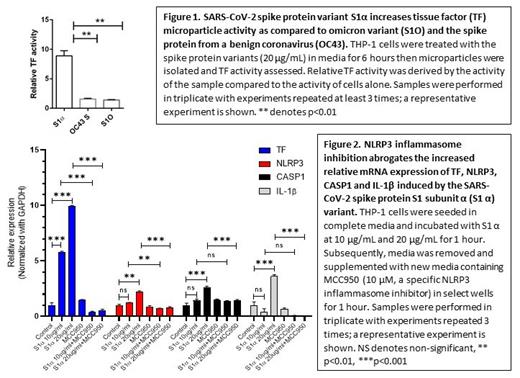Introduction: An exaggerated inflammatory response both locally and systemically mediated by innate immune signaling is a near universal feature of severe COVID-19 illness and has been associated with multi-organ damage and thrombosis. As part of an antiviral response, activation and formation of the intracellular NLRP3 inflammasome leads to expression of proinflammatory IL-1 family cytokines. In macrophages, the NLRP3 inflammasome is linked to the release of tissue factor (TF) bearing microvesicles. Multiple studies provide evidence of NLRP3 inflammasome activation in COVID-19 including increased IL-1β in monocytes, sera, and bronchoalveolar lavage fluid from COVID-19 patients. Patient monocytes bear features of inflammasome activation, which correlate with disease severity (Potere et al. Cardiovascular Research 2023). Given the central role of thromboinflammation in COVID-19, we explored the ability of various coronavirus spike proteins to increase TF activity in a monocytic cell line. Mechanistically, we sought to explore the role of the NLRP3 inflammasome in SARS-CoV-2 spike protein triggered tissue factor generation.
Methods: The SARS-CoV-2 α variant S1 subunit (S1α) and Omicron variant BA.1.1.529 S1 (S1O) recombinant proteins were obtained from Raybiotech and OC43, a non-COVID respiratory human coronavirus, recombinant spike protein (OC43 S) from Sino Biological. THP-1 cells at a concentration of 2x10 6/mL were incubated with spike proteins at 37°C in RPMI, supplemented with 10% fetal bovine serum. A specific NLRP3 inflammasome inhibitor (MCC950) was incubated with select samples for 1 hour following addition of the spike protein. The cells were harvested, subjected to RNA extraction and cDNA synthesis by reverse transcription. TF, NLRP3, caspase (CASP)-1, and IL-1β relative mRNA expression was quantified using RT-PCR and normalized to GADPH expression. For quantifying microparticle TF activity, cells were incubated with the spike proteins for 6 hours then microparticles were isolated from the supernatant after centrifugation at 20,000 g for 30 minutes at 4°C, washed and TF activity was measured using a two-stage chromogenic assay kit (Abcam). A monoclonal anti-TF antibody (Santa Cruz) was used to confirm specificity for TF generation. Experiments were performed in triplicate. Data is presented as mean ± standard deviation. The student t test was used to assess the difference between unpaired groups with a value of p <.05 considered statistically significant.
Results: Our previous data showed that S1α, but not S1O or OC43 S, leads to increased TF mRNA expression in THP-1 cells in a dose dependent manner. Here we show TF microparticle activity was increased with S1α (20 µg/mL) as compared to incubation of THP-1 cells with S1O or OC43 spike proteins (20 µg/mL), which were comparable to the activity of cells alone ( Figure 1). After treatment with S1α (20 µg/mL) for 1 hour, we found increased expression of TF (10-fold), NLRP3 (2-fold), CASP-1 (3-fold), and IL-1β (3.5-fold). Treatment with S1O and OC43 S did not lead to a significant change in relative mRNA expression of TF, NLRP3, CASP-1, and IL-1β. Following incubation with the S1α spike protein for 1 hour, cells were re-plated in fresh media containing 10 µM MCC950. Treatment with MCC950 significantly reduced expression of TF, NLRP3, CASP-1, and IL-1β ( Figure 2).
Conclusion: We confirmed that TF expression induced by the S1α spike protein leads to an increase in TF activity, as assessed by microparticle generation. The NLRP3 inflammasome is a mediator of coagulopathy induced by the spike protein, and TF, CASP-1, and IL-1β expression are abrogated after specific NLRP3 inflammasome inhibition. TF activity and inflammation induced by the coronavirus spike proteins in vitro correlates with the respective clinical phenotype and disease severity of the variants. This suggests that the effects of SARS-CoV-2 on TF and inflammasome activation derive in part from the spike protein, and these assays may be useful in predicting the effects of spike protein variants.
Disclosures
Brodsky:Alexion, AstraZeneca Rare Disease: Research Funding. Gerber:Pfizer (spouse): Current Employment, Current equity holder in publicly-traded company; Merck: Honoraria; Apellis Pharmaceuticals: Consultancy; Alexion Pharmaceuticals: Consultancy.


This feature is available to Subscribers Only
Sign In or Create an Account Close Modal